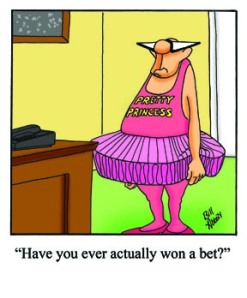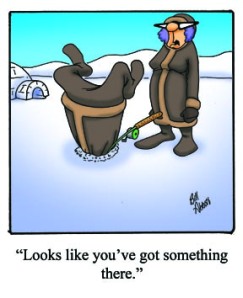It happens to all of us, and its likely you’ve read at least something about the mountain of rejections that come with the territory as cartoonists and artists. But reading about it, and actually dealing with it are completely different things. That being said, I’m hoping this article will provide you with some mental strategies to put your focus on where it should be rather than on where it shouldn’t.
As mentioned, rejection is not only a large part of this business, but its a part of life. And just as in life, the better you learn to handle adversity, the likelier you’ll achieve what you want. Simple, right? Not right.
During my brief and colossally unfocused college experience, I learned a few life lessons. One, drinking beer rather than attending class may have a negative impact on your grades. Two, I was intellectually better suited for weight training than philosophical studies. And three, perspective is key. What do I mean by that? In law class, the professor described the importance of obtaining the complete picture of an event. In so doing, you’ll have to talk to every available witness, and compare what they observed with what others observed. Surprisingly, people will witness the same event and recall the experience with total clarity and an abundance of detail. Only it doesn’t match what another credible witness describes – how can that be? Perspective. Hold up a quarter with heads facing you, tails facing outward. Ask someone in front of you to describe what they see. It’s the same coin observed at the same moment, but the difference in perspective will provide a substantially different set of details. So it is with rejection. How do you choose to see it?
I’ve read somewhere an interesting tidbit about Babe Ruth, the legendary home run king. Not only did he knock more balls clear out of the park than anyone else in his time, and for quite a time thereafter, but he also struck out more than anyone else. He wasn’t put off or defeated by the misses, as great a number as they were – more than anyone else’s, but he had to have remained focused on the idea of succeeding. Stepping up to the plate and giving his best every time and letting the outcome be what it will be. Forgetting about the last three strike-outs – it’s only this at-bat, this singular moment that counts. Once it’s passed, it’s time to focus on the next opportunity to swing, and so on. Looking back should be to glean something beneficial from the experience: how could I have done that better, is there an opportunity to improve, what feedback am I getting that I can make actionable and advance my goals? Then turn back around and focus on your next chance to succeed.
Here’s an exercise worth trying. What was your last disappointment? How did you take it? Did you automatically categorize it as a defeat, a rejection not only of your work, but of you personally? Was there a sudden loss of motivation that impacted other areas of your day? From what perspective were you looking at the rejection? Lets take that same event, but flip the coin. Were there any opportunities to learn? Were you still focused on what was ahead of you or were you driving forward while looking at the rear view mirror? Did you ask for feedback – why the work didn’t meet the needs of your prospective client or buyer? Were there opportunities to close the gap between where you are and where you want to be? It’s my belief that you learn far, far more in defeat than in victory, which makes defeat, if we are to call it that, fertile ground for opportunity.
Having had no shortage of rejections, I’ve had ample opportunity to learn some of the reasons why my submitted work didn’t get it done. Sometimes, it’s just not the right time – the company or publication may have run something too similar in the recent past, or the style is redundant in what they already have. It may be a matter of fiscal policy – they’re getting behind another property and can’t invest in anything new at this time even though they value your work. It could be stylistically wide of the mark – great art, but not for their audience. Or it could be the editor or creative director woke up to a broken coffee maker and there’ll be hell to pay, and your submission was the first they vented on. Whatever the reasons, always remember that your perspective is the one that counts the most. Momentum is directed by perspective – forward or backward, you decide.
One of the methods I use to keep my head screwed on straight with regard to rejection, is a term I’ve borrowed from the military, Fire and Forget. I fire off my submissions, forget them and move straight into creating the best work for submitting again in the next round. When rejection comes as it always does, I seek information on how to improve or when to resubmit. With Fire and Forget, I’m too busy setting up for tomorrow to worry about what I did yesterday, and how others reacted to it.
Remember this: your work has value. Some markets, some art directors, and some time frames may not be receptive, but that should have no bearing on what you want to achieve and your mission-oriented drive to get you there.




Thanks. Your cartoons are great and the info was very helpful. I hadn’t thought about asking ‘why’ I am just starting in this licensing field so I am sure I will get a chance to do that.
Thank you Diane – glad you found it helpful!
So wise! Thanks for providing the fun cartoons along the way, too.
Glad you enjoyed it – thank you!
Reblogged this on JOANA MIRANDA STUDIO and commented:
For my readers: Need some strategies for how to deal with rejection?Then read this wise (and humorous) post by a cartoonist I admire. about dealing with rejection by a cartoonist
Sorry about the typo (sentence fragment above) at the end of my reblog comment. I’ve corrected it on my blog. Joana
Joana
Thanks for the excellent advice, Bill! I have a real talent for zeroing in on those art directors with broken coffee makers – maybe I will change my perspective & open a side business in small appliance repair.
You may be on to something there!
Your posta are always interesting Bill. Thanks!
Glad you like them Steve!
Thanks Bill – I needed this reminder today!
I’m glad you found value in it! Really enjoyed your photography!
Thank you Bill. From you, the compliment about my photography means even more. I have always enjoyed your work and its humorous perspective on life! : )
Pingback: Dealing With Rejection For Cartoonists and Artists - mafia art blog
Bill, we are so invested in our art that it is difficult to separate the work from our selves. I read once that to be a great artist we have to be sensitive, aware and vulnerable in order to see the world around us. But at the same time we have to strong in order to deal with the business and rejection of our art. This is a fine line we walk in order to be a creative but necessary in order to survive.
Thanks for a great article and perspective. It is always good to remind ourselves that they are rejecting the work not us.
You make some good points Lee – I’m glad you liked the article.
Great article – Thanks for sharing. I’m also enjoying your very funny cartoons.
Phenomenal way of putting it, Bill. I’m sharing this with my artist friends
Thank you Sarah – it was my hope that it would be of some value to my fellow artists. I get so many emails from people who feel completely defeated by rejection. Heck, I’ve made being a reject a lifestyle!
Thank you for the great article about the tough topic of rejection. This is an article that I will have to read again and as others have mentioned I need to share it with my artist friends.
Thank you Christine!
Excellent, Bill! Rejection always gets me, no matter how logically I try to think about it. Maybe this different approach (looking forward rather than back) will be more effective for me. Thanks for sharing it!
You’re welcome Kathy – and believe me – it works!
I always say, if you’re not getting rejected, you’re just not trying hard enough. having been in the fine art biz for over 35 years, I’ve had my share of rejection (and successes, I should say.) While I mostly can shake them off, they do still sting. That however, is no reason not to keep putting myself out there. And now I’ve added new creative areas in which to be rejected. Huzzah! Thanks for this great post.
You’re very welcome Bob – and best of luck with the new creative areas!
Bill,
Thanks for a great blog and article. I was picked up by a magazine to be a regular cartoon contributor last year after many previous unsuccesses, so I understand your points about needing to persevere.
Do you know the best way to submit to Reader’s Digest? I can’t find any good advice on who to send to or how.
Thanks for your help.
Gene Browning
Congratulations Gene! I just emailed you the information you’re looking for – good luck!